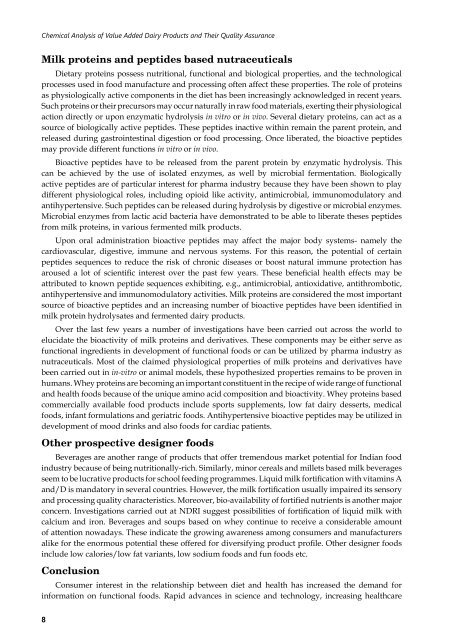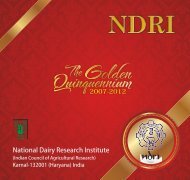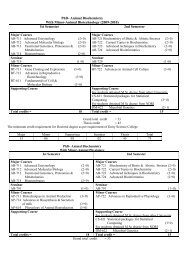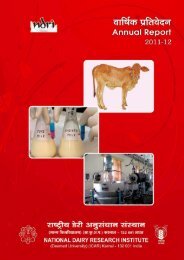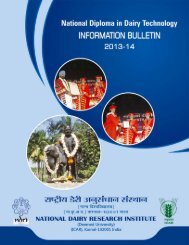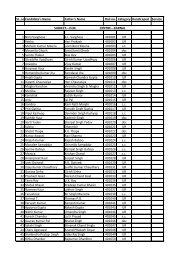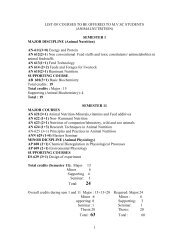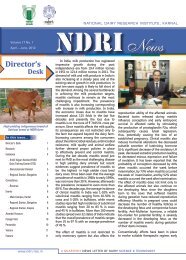Chemical Analysis of Value Added Dairy Products and Their Quality ...
Chemical Analysis of Value Added Dairy Products and Their Quality ...
Chemical Analysis of Value Added Dairy Products and Their Quality ...
Create successful ePaper yourself
Turn your PDF publications into a flip-book with our unique Google optimized e-Paper software.
<strong>Chemical</strong> <strong>Analysis</strong> <strong>of</strong> <strong>Value</strong> <strong>Added</strong> <strong>Dairy</strong> <strong>Products</strong> <strong>and</strong> <strong>Their</strong> <strong>Quality</strong> AssuranceMilk proteins <strong>and</strong> peptides based nutraceuticalsDietary proteins possess nutritional, functional <strong>and</strong> biological properties, <strong>and</strong> the technologicalprocesses used in food manufacture <strong>and</strong> processing <strong>of</strong>ten affect these properties. The role <strong>of</strong> proteinsas physiologically active components in the diet has been increasingly acknowledged in recent years.Such proteins or their precursors may occur naturally in raw food materials, exerting their physiologicalaction directly or upon enzymatic hydrolysis in vitro or in vivo. Several dietary proteins, can act as asource <strong>of</strong> biologically active peptides. These peptides inactive within remain the parent protein, <strong>and</strong>released during gastrointestinal digestion or food processing. Once liberated, the bioactive peptidesmay provide different functions in vitro or in vivo.Bioactive peptides have to be released from the parent protein by enzymatic hydrolysis. Thiscan be achieved by the use <strong>of</strong> isolated enzymes, as well by microbial fermentation. Biologicallyactive peptides are <strong>of</strong> particular interest for pharma industry because they have been shown to playdifferent physiological roles, including opioid like activity, antimicrobial, immunomodulatory <strong>and</strong>antihypertensive. Such peptides can be released during hydrolysis by digestive or microbial enzymes.Microbial enzymes from lactic acid bacteria have demonstrated to be able to liberate theses peptidesfrom milk proteins, in various fermented milk products.Upon oral administration bioactive peptides may affect the major body systems- namely thecardiovascular, digestive, immune <strong>and</strong> nervous systems. For this reason, the potential <strong>of</strong> certainpeptides sequences to reduce the risk <strong>of</strong> chronic diseases or boost natural immune protection hasaroused a lot <strong>of</strong> scientific interest over the past few years. These beneficial health effects may beattributed to known peptide sequences exhibiting, e.g., antimicrobial, antioxidative, antithrombotic,antihypertensive <strong>and</strong> immunomodulatory activities. Milk proteins are considered the most importantsource <strong>of</strong> bioactive peptides <strong>and</strong> an increasing number <strong>of</strong> bioactive peptides have been identified inmilk protein hydrolysates <strong>and</strong> fermented dairy products.Over the last few years a number <strong>of</strong> investigations have been carried out across the world toelucidate the bioactivity <strong>of</strong> milk proteins <strong>and</strong> derivatives. These components may be either serve asfunctional ingredients in development <strong>of</strong> functional foods or can be utilized by pharma industry asnutraceuticals. Most <strong>of</strong> the claimed physiological properties <strong>of</strong> milk proteins <strong>and</strong> derivatives havebeen carried out in in-vitro or animal models, these hypothesized properties remains to be proven inhumans. Whey proteins are becoming an important constituent in the recipe <strong>of</strong> wide range <strong>of</strong> functional<strong>and</strong> health foods because <strong>of</strong> the unique amino acid composition <strong>and</strong> bioactivity. Whey proteins basedcommercially available food products include sports supplements, low fat dairy desserts, medicalfoods, infant formulations <strong>and</strong> geriatric foods. Antihypertensive bioactive peptides may be utilized indevelopment <strong>of</strong> mood drinks <strong>and</strong> also foods for cardiac patients.Other prospective designer foodsBeverages are another range <strong>of</strong> products that <strong>of</strong>fer tremendous market potential for Indian foodindustry because <strong>of</strong> being nutritionally-rich. Similarly, minor cereals <strong>and</strong> millets based milk beveragesseem to be lucrative products for school feeding programmes. Liquid milk fortification with vitamins A<strong>and</strong>/D is m<strong>and</strong>atory in several countries. However, the milk fortification usually impaired its sensory<strong>and</strong> processing quality characteristics. Moreover, bio-availability <strong>of</strong> fortified nutrients is another majorconcern. Investigations carried out at NDRI suggest possibilities <strong>of</strong> fortification <strong>of</strong> liquid milk withcalcium <strong>and</strong> iron. Beverages <strong>and</strong> soups based on whey continue to receive a considerable amount<strong>of</strong> attention nowadays. These indicate the growing awareness among consumers <strong>and</strong> manufacturersalike for the enormous potential these <strong>of</strong>fered for diversifying product pr<strong>of</strong>ile. Other designer foodsinclude low calories/low fat variants, low sodium foods <strong>and</strong> fun foods etc.ConclusionConsumer interest in the relationship between diet <strong>and</strong> health has increased the dem<strong>and</strong> forinformation on functional foods. Rapid advances in science <strong>and</strong> technology, increasing healthcare8


